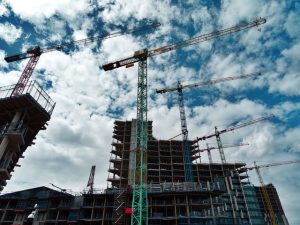From residential jobs to industrial construction to Commercial real estate in Melbourne to public work jobs, cranes are indisputably instrumental around the globe at building sites. Cranes permit heavy payloads to be raised safely and correctly. A vast assortment of crane kinds exists, plus they lift payloads safely and accurately anywhere from one foot high to permit horizontal transport to hoisting up items over 30 stories high.
On building sites, cranes hire serve two chief functions. To begin with, cranes help transfer or deliver heavy equipment and components from one area of the construction website to another. Secondly, cranes lift structures and equipment into place.
As described by the Civil Engineering Portal, cranes for building are normally temporary constructions, either fixed to the floor or mounted on a purpose built automobile. Among the most notable constructions on a building site is your tower crane.
A BrightHub Engineering informative article on the several distinct kinds of cranes employed by the building business notes that tower cranes have been utilized in the construction of tall buildings may reach around 265 feet, out to 230 feet, and raise a total of roughly 20 tons. However, in spite of its impressive reach and load capacity, the tower includes a significant drawback.
The report continues by saying they are fixed into the floor during the building period and also are continuously mounted above a solid concrete mat so that anchor bolts could be inserted to the mat, which hold the tower crane when it’s lifting heavy loads. Since they have to be transported, assembled, and disassembled, these cranes are often only installed at sites participating in constructing tall structures.
Though many cranes are transported to and from building sites, and many kinds of cranes demand assembly, and disassembly, most cranes are mobile such as frannas. They may be mounted on trucks or trucks equipped with motors to permit for freedom around the work site, between sites, and on the street. Mobile cranes are varied and satisfy an assortment of requirements on building sites. Below are the significant classes of mobile cranes and their benefits.
- Vehicle Mounted Cranes: mobile cranes of the type are often utilized in the transport of gear to and from worksites. A telescopic boom is mounted on a mobile stage and hinged at the base and may be raised or lowered by cables or hydraulic cylinders (Civil Engineering Portal). Often outriggers are combined with these kinds of cranes in the truck’s foundation for stability when lifting loads within a particular weight (max weight’s fluctuate based on rig specifications). These cranes are best for freedom across mountainous regions and can safely drive long distances only a few mph under most street speed limits.
- Hydraulic Truck Cranes: A post titled, 5 kinds of Cranes and What They Are Employed For, calls hydraulic truck cranes “the norm in mobile cranes” and names them as crucial to construct important projects like buildings, bridges, airports, roadways, and much more. Using hydraulic lifts, these portable cranes can browse a worksite, and handle heavy payloads to the thousands of pounds.
- Loader Crane: Another hydraulic crane, this kind of crane has been “fitted into a trailer” rather than mounted onto a truck. Its hydraulic arm is “utilized to load gear on a trailer. The many sections could be folded into a tiny space once the crane is not in use (Civil Engineering Portal).
- Tough Terrain Crane: For construction websites with unlevelled floor or access points which are irregular or unstable, rough terrain cranes supply a secure choice for moving heavy components and equipment or even erecting structures. Rough terrain cranes are only engine cranes mounted on trucks that may extend both horizontally and vertically. Brighthub Engineering notes tough terrain cranes have been mounted into an undercarriage that’s rubberized tires especially employed for off-road software and adds they’re frequently utilized in combination with outriggers for stability. According to, 5 kinds of Cranes and What They Are Employed For, this kind of crane requires transportation to the job site by truck or lowboy since they’re only permitted on public highways in Japan.
- All Terrain Cranes: All of the advantages of rough terrain cranes listed above come with this kind of crane. Furthermore, they operate well on paved highways and may reach speeds of around 40 mph irrespective of terrain so transportation to and from the building site isn’t vital. These sort of cranes go hand-in-hand when civil works need to be carried out.
- Crawler Crane: All these self-propelled cranes are portable but don’t need outriggers to stabilize once erected. Since BrightHub Engineering explains they’re mounted into a chassis using a set of monitors rather than tires and includes a lifting capacity by 40 tons to 3500 tons. Such as the thick monitors used to propel tanks ahead, these cranes derive their stabilized form out of their depth and the weight of the crane itself. Crawler cranes are perfect for usage in hoisting on non-paved surfaces but proceed slowly and consequently must be hauled to and from the building site and therefore are generally disassembled and then reassembled on site.
When choosing a crane to work with on a building site, the height and weight abilities demanded of the crane in addition to the sort of construction site along with the topography of the site ascertain which crane needs to be used.

Assembling your own business construction entails a huge investment of money and time, and therefore you want to be sure it is the ideal move for your industry.
As soon as you’ve resolved to move, do not expect a smooth ride. Unforeseen issues like budget overruns, undependable contractors and flaws are typical. You need to be ready to handle change when it occurs. Cloud computing allows you monitor all this online. The longer that you have, the better equipped you should adjust your plans accordingly.
Assess your options
The absolute scale of a building project needs a significant commitment from virtually any entrepreneur. Remember the energy and time spent in constructing a building might also be placed to the company itself. Even in the event that you employ a project manager to oversee the project, you will still have to get involved in daily decision-making, which will necessarily mean more time away from daily operations.
Consider different situations like leasing office space, purchasing another building, asset management or renovating existing area. When in doubt, locate a financial adviser or advisor to help assess your own situation. As soon as you’ve carefully ascertained your aims, you may even request architects and interior designers to help find the ideal solution for you.
No matter your choice, another important aspect to think about is your long-term demands. Will the building be in a position to accommodate your expansion in the future? You do not need to wind up outgrowing your new construction too fast and never have to make extra costly investments.
Be prepared with a contingency strategy
Nonetheless, it is not always feasible to forecast prices, so make sure you cover more costs with a contingency program representing 5 percent to 10 percent of the entire job price. In spite of a fixed-price contract, facets of this project–such as extra landscaping expenses, plumbing and electrical modifications to accommodate gear and shifting costs, could be overlooked.
Get your finances in order
Do not wait till the final minute to understand your bank on your funding needs. Get your lender involved from the start. It is never too early. By utilising cloud computing services you can keep all your business needs online in one spot.
A bank adviser can help companies determine a building’s worth and just how much money they will need from beginning to finish. Businesses looking for financing must expect to show they’ve a wholesome balance sheet and are proving adequate gains.



